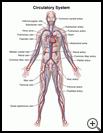
Pulmonary Embolism
What is a pulmonary embolism?
A pulmonary embolism happens when an artery in one of your lungs becomes blocked. In most cases, the blockage is caused by one or more blood clots that travel to your lungs from another part of your body. A blood clot that travels through the blood vessels is called an embolus.
Blood clots most often form in leg veins, but can also start in the arm veins or in the right side of the heart. You are at a higher risk for forming a blood clot if:
- You must lie or sit still for a long time when recuperating from an illness or injury or when taking a long plane flight or car ride
- You have recently had surgery
- You have inherited a disorder that makes your blood clot more easily than normal
- You take a medicine that increases the tendency for blood to clot, such as birth control pills
- You have certain types of cancer such as brain, lung, pancreas, liver, or leukemia, or others
A pulmonary embolism can be a life-threatening problem.
What can I expect in the hospital?
Several things may be done while you are in the hospital to monitor, test, and treat your condition. They include:
Monitoring
- You will be checked often by the hospital staff.
- A heart (cardiac) monitor will be used to keep track of your heartbeat.
- Your blood oxygen level will be monitored by a sensor that is attached to your finger or earlobe.
- Your fluid intake may be monitored closely by keeping track of everything you eat and drink and any IV fluids you receive.
- You may have a small tube (catheter) placed into your bladder to drain and measure urine.
Testing
Testing may include:
- Arterial blood gas (ABG), which is blood test to measure the levels of oxygen and carbon dioxide in your blood
- Blood tests to check for infections and to see how well your blood is clotting
- A chest X-rays to check for infections or other problems
- Computed tomography angiography (CTA) uses contrast dye injected into a vein. Then a series of X-rays is taken while X-ray detectors in the CT machine rotate around you and the X-ray table moves through the CT machine. This is called a spiral CT. It will allow the provider to see any blood clots in the blood vessels in your lungs.
- An ECG (also called an EKG or electrocardiogram), which measures and records your heartbeat
- Ultrasound scan uses sound waves and their echoes passed through your body from a small device that is held against your skin to create pictures of the inside of the legs to help look for clots.
- Lung scans, which show how well blood or air flows through the lungs
- Ultrasound (echocardiogram), which uses sound waves and their echoes passed through your body from a small device that is held against your skin to create pictures of the inside of your heart
Treatment
The treatment for pulmonary embolism depends on your symptoms, how well you respond to treatment, your overall health, and any complications you may have.
- You will have a small tube (IV catheter) inserted into a vein in your hand or arm. This will allow medicine to be given directly into your blood and to give you fluids, if needed.
- You will receive oxygen through a small tube placed under your nose or through a mask placed over your face.
- Your provider may prescribe medicines to:
- Treat pain
- Prevent clots from getting bigger and stop more blood clots from forming
- Dissolve or break down blood clots
- Your provider may recommend other types of therapy to help relieve pain, other symptoms, or side effects of treatment.
- You may need surgery to remove the pulmonary embolus. Surgery may include:
- Pulmonary embolectomy, which may be done through:
- Catheter-directed embolectomy, in which a catheter is placed into a blood vessel in your groin and up to blood vessel blocked by the clot to remove the clot
- Surgical embolectomy, in which a cut is made in the chest and the clot is removed from the artery
- Vena cava filter placement, where a small plastic filter is placed in the large abdominal vein that returns blood to the heart. The filter is placed through a catheter that is put into a blood vessel in your groin and up to the correct area. It can trap blood clots and prevent them from reaching your lungs.
- Pulmonary embolectomy, which may be done through:
What can I do to help?
- You will need to tell your healthcare team if you have new or worsening:
- Shortness of breath
- Chest pain
- Coughing up blood
- Pain, redness, or swelling in your legs
- Dizziness or lightheadedness
- Severe headaches
- Severe stomach pain
- Increased weakness
- Red or brown urine
- Unusual bruising
- Red or black bowel movements
- Unexpected bleeding from any part of your body
- Signs of infection around your surgical wound if you had surgery. These include:
- The area around your wound is more red or painful
- Your wound area is very warm to touch
- You have blood, pus, or other fluid coming from the wound area
- You have chills or muscle aches
- Ask questions about any medicine or treatment or information that you do not understand.
How long will I be in the hospital?
How long you stay in the hospital depends on many things, such as your general health, why you are in the hospital, the treatment you need, and how well you recover. This is often between 5 to 7 days. Talk with your provider about how long your stay may be.
Last modified: 2016-07-05
Last reviewed: 2016-06-30

